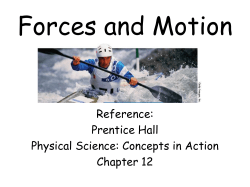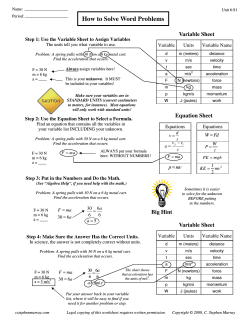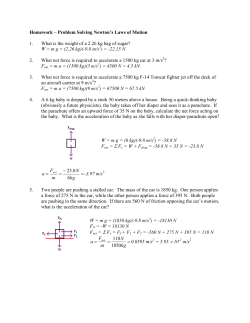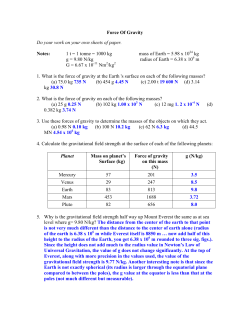
PHY131H1F - Class 9
PHY131H1F - Class 9 Which Newton’s Second Law is best? Today, Chapter 5 “Force and Motion”: • Newton’s First Law Randall Knight prefers to group the causes on the right hand side of the equals sign, and effects on the left hand side of the equals sign. This author’s preferred way of writing Newton’s Second Law of motion is: • Newton’s Second Law A. a Fnet m • Forces • Free Body Diagrams • Test 2 is on Nov. 20, less than 6 weeks from now B. Fnet ma C. m Fnet a Last day I asked at the end of class: • A paperback novel has a mass of 0.3 kg and slides at a constant velocity of 5 m/s, to the right. A physics textbook has a mass of 3.0 kg, and slides at a constant velocity of 5 m/s, to the right. How does the net force on the textbook compare to the net force on the novel? • ANSWER: SAME – zero! • The net force on any object is proportional to its acceleration. • In the case of these two books, they are both traveling at a constant velocity, meaning acceleration is zero. • Any friction must be offset by some pushing force, not mentioned in the question. What is a force? • A force is a push or a pull on an object. • A force is a vector. It has both a magnitude and a direction. • A force requires an agent and a recipient. Something does the pushing or pulling, and something else gets pushed or pulled. • A force is either a contact force (like normal) or a long-range force (like gravity). • The S.I. unit of force is the Newton (N) • N is not a fundamental unit; it can be broken down into fundamental units: Isaac Newton • Born in 1643, the year Galileo died. • Was a “physicist, mathematician, astronomer, natural philosopher, alchemist, and theologian and one of the most influential people in human history.” (http://en.wikipedia.org/wiki/Isaac_Newton) • In Philosophiæ Naturalis Principia Mathematica, published 1687, he described universal gravitation and the three laws of motion, laying the groundwork for classical mechanics. Tactics: Drawing force vectors 1 A Short Catalog of Forces The 5 forces we deal with most often in PHY131 are: 1. Gravity (Fg = mg) 2. Normal Force 3. Tension 4. Kinetic Friction ( fk = μkn) 5. Static Friction …plus there are others which come up less frequently, such as: spring force, drag (a.k.a. air resistance), rolling friction, thrust, the electric force, the magnetic force Normal Force Gravity FG mg FG “The Earth exerts a gravity force on the angry bird.” Tension “The rope exerts a tension force on Harlow.” “The diving board exerts a normal force on the dog.” Kinetic Friction “The ground exerts a kinetic friction force on Suleyman.” where n is the magnitude of the normal force, and μk is a constant, which happens to be low for plastic on snow. Static Friction “The ground exerts a static friction force on the shoe.” 2 Multiple Forces on a Single Object The Net Force • A car is parked on flat, horizontal pavement. • Which of the following forces are acting on the car? A.Gravity B.Normal C.Static friction D.Both A and B E.A, B and C • A car is parked on flat, horizontal pavement. • The “net force” is the vector sum of all the forces on the car. • What is the direction of the net force on the car? A. Up B. Down C. The net force is zero • • • • Test 1 Results are posted Test 1 Results are posted Look under “My Grades” on the portal Average was 25/40 = 63% 26 students got 40/40 = 100% 40% of students got As or Bs on this test • Your test will be returned to you in Practicals next week. • Please have a look at it, compare with the posted solutions, and make sure you understand where you lost marks. • Test 2 is on Nov. 20, less than 6 weeks from now • Test 2 will cover Chapter 4-11 and the first 6 sections of Chapter 12 • The Final Exam in December counts for 40% of your mark, and covers the entire course Number of Students 180 160 140 120 100 80 60 40 20 0 0-9 10-19 20-29 30-39 40-49 50-59 60-69 70-79 80-89 90-100 Test 1 Percentage Your Test 1 Mark in PHY131 does not define your destiny! • Test 1 is worth 15% of your final mark • Test 2 and the Final exam count for 55% • Practicals counts for 15%, and marks are often in the B-range • MasteringPhysics and clickers count for the other 15%, and are often in the 90+ range • Keep up with all assignments, keep going to class, keep practicing! How to Improve Your Mark • Work studying for Physics into your daily and weekly schedule • Carefully review and master: 1. 2. 3. 4. 5. Examples in the text MasteringPhysics Problem Sets Assigned Practicals Activities In-class clicker questions End-of-chapter suggested problems • Make sure you understand the questions well enough that you can teach it to your friends 3 Recall a clicker question asked on October 1: You drop a glass barometer from the top of McLennan Physical Labs. A short time later, before the barometer hits the ground, you drop a bottle of scotch. The Fundamental Forces of Nature There are four fundamental forces in nature: 1. Gravity 2. Electromagnetism 3. Weak Nuclear Force 4. Strong Nuclear Force • Gravity is always attractive, and acts between any two objects. • Electromagnetism causes repulsion and attraction between charged particles, such as the protons and electrons in matter. This gives rise to almost all of the forces we deal with in PHY131/132: Normal, Tension, etc. • Weak and Strong Nuclear forces are important in understanding how atomic nuclei are held together and certain forms of radiation – not important for PHY131/132. 1 Newton’s First Law The natural state of an object with no net external force on it is to either remain at rest or continue to move in a straight line with a constant velocity. What is Mass? • Mass is a scalar quantity that describes an object’s inertia. • It describes the amount of matter in an object. • Mass is an intrinsic property of an object. • It tells us something about the object, regardless of where the object is, what it’s doing, or whatever forces may be acting on it. 2 Newton’s Second Law The acceleration of an object is directly proportional to the net force acting on it, and inversely proportional to its mass. F a net m 4 A fan attached to a cart causes it to accelerate at 2 m/s2. Suppose the same fan is attached to a second cart with smaller mass. The mass of the second cart plus fan is half the mass of the first cart plus fan. The acceleration of the second cart is A. 16 m/s2. B. 8 m/s2. C. 4 m/s2. D. 2 m/s2. E. 1 m/s2. Three forces act on an object. In which direction does the object accelerate? Projectile Motion Example • An angry bird of mass m = 0.12 kg is flying through the air. His wings are tucked in, and air resistance is negligible. • What is the acceleration of the bird? Mass on Frictionless Inclined Plane Example θ • A cart of mass m = 0.195 kg is rolling on a track that is inclined at an angle θ above the horizontal. Friction is negligible. • What is the acceleration of the cart? Problem Solving Strategy • Acceleration is the link between dynamics and kinematics. • From Fnet, find a. • From a and initial conditions, find vx, vy, x, y. • a = 0 is the condition for equilibrium. • “static equilibrium” is when a = 0 and v = 0. • “dynamic equilibrium” is when a = 0 and v ≠ 0. • Equilibrium occurs if and only if Fnet = 0. Challenge Question • A green ball swings back and forth between positions 1, 2 and 3. Fg is the magnitude of the force of gravity on the ball. T is the magnitude of the tension force on the ball. At the instant the ball is in position 2, A. Fg > T B. Fg < T C. Fg = T 5 Before Class 10 on Monday • Don’t forget the MasteringPhysics Problem Set due on Friday! • Please read Chapter 6 of Knight, sections 6.1 through 6.3. • Something to think about: A basketball and a tennis ball are in freefall. 1. 2. 3. 4. Which, if either, has the larger mass? Which, if either, experiences the larger force of gravity? Which, if either, experiences the larger acceleration? Which, if either, has the larger weight? 6
© Copyright 2025





















